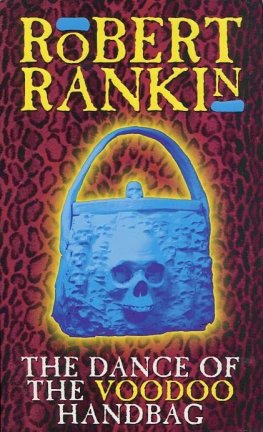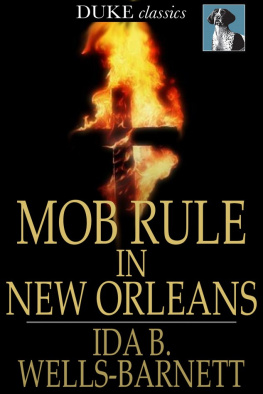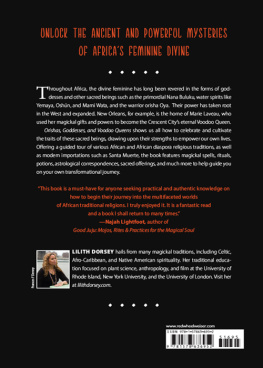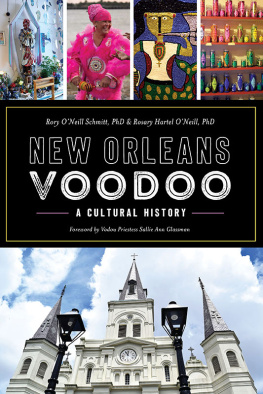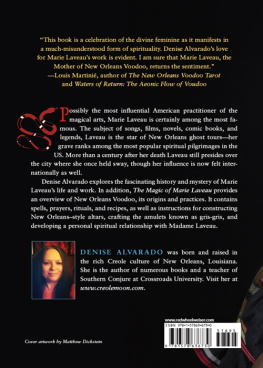Voodoo in
New Orleans
BY
ROBERT TALLANT
Copyright 1946, 1974
By Robert Tallant
Copyright 1980
By Mary L. Gibbs
All rights reserved
First published by Macmillan
Pelican paperback edition
First printing, October 1983
Second printing, January 1990
Third printing, January 1994
Fourth printing, February 1998
Fifth printing, April 2003
Sixth printing, January 2012
Library of Congress Cataloging in Publication Data
Tallant, Robert, 1909-1957.
Voodoo in New Orleans.
Reprint. Originally published: New York: Macmillan, 1946.
Bibliography: p.
1. VoodooismLouisianaNew Orleans. 2. New Orleans (La.)Religious life and customs. I. Title.
BL2490.T3 1983 299.67 838261
ISBN 9780882893365, print; ISBN 9781455613694, ebook
Printed in the United States of America
Published by Pelican Publishing Company, Inc.
1000 Burmaster Street, Gretna, Louisiana 70053
Foreword
MUCH nonsense has been written about Voodoo in New Orleans. It seems to me that here is a truthful and definitive picture.
Robert Tallant has done several years research on the subject and, in addition, has consulted some of the files collected by the Louisiana Writers Project, now in the possession of the Louisiana Library Commission in Baton Rouge, Louisiana.
When I read Mr. Tallants manuscript I was highly pleased with his accuracy and integrity and I think he has made extremely good use of all his material.
LYLE SAXON
S T . C HARLES H OTEL , N EW O RLEANS
1944
Acknowledgments
PARTICULAR acknowledgments are due Miss Essae M. Culver, Executive Secretary of the Louisiana Library Commission, Mrs. Joel Doane Howerton, of Meridian, Mississippi, Miss Caroline M. Burson, Miss Hazel Breaux and Robert McKinney, each of whom, in one way or another, lent assistance.
I want, too, to thank all the people, white and colored, many of whose names I do not even remember, who offered information without which the material for this book could never have been gathered.
And I am very grateful to all those who wrote of my city before meAlce Fortier, Charles Gayarr, Lafcadio Hearn, George W. Cable, Henry Castellanos, Grace King, Dr. William A. Read, Charles Dudley Warner, Edward Larocque Tinker, Herbert Asbury and, most of all, Lyle Saxon, to whom my debt is beyond measure.
R. T.
FOR MY MOTHER
Part I
THIS IS THE WAY IT WAS
1
Evolution
SOMETIMES a white man in New Orleans takes a walk along South Rampart Street, one of the famous Negro thoroughfares of America. He turns at Canal Street, the citys most important business street, and immediately he finds himself in a new world, with its own particular sights and sounds and smells.
Canal Street is a great wide boulevard, filled with department stores and shops and moving picture theaters. There is the usual crowd of city people, most of them white. South Rampart Street is also lined with places of business and entertainment, but the faces of its people are much darker. Here the white man will seldom see another white face, except for the proprietors and clerks of some of the stores and shops and the other establishments typical of such Negro districts. There are pawnshops, barber shops and beauty parlors, poolrooms and barrooms, night clubs and restaurants, shoeshine stands, small hotels and movies.
Jazz is the sound of South Rampart Street. It comes from every doorway, from every directionfrom juke boxes, from the phonographs in the music stores, wherein the customers seem always to be playing recordings made by Negro bands and artists, from radios in shoeshine stands and barber shops, sometimes from an old-time inner player piano beyond an upstairs window.
The white man will never forget the smells of South Rampart Street: stale beer and whiskey, oyster barrels too long in the hot sun, hamburgers-with-onions frying on griddles at open windows, a musky mingling of perspiration and cheap perfume, and the curious odor of incense that lingers at some doorways.
The white man walking on South Rampart Street is a foreigner. Unless he has some business errand here he is soon conscious of this fact. He may even begin to wonder if a Negro ever feels as strange when he walks on a white mans street, though he knows Negroes understand white men much better than white men understand Negroes. It seems to the white man that on South Rampart Street the Negro has in his mysterious way built a world for himself, and an amazing and colorful one at that. There is much that duplicates all the streets in which white men conduct and patronize their own business, and much that is very similar to the white mens way of finding recreation and pleasure. Yet there is something else here that is different and of another race.
The white man may feel he is an intruder here, but when he comes to a group of Negroes on the banquettethe New Orleans word for what is called a sidewalk elewhere in the countrythe Negroes step aside to let him pass. Generations of stepping aside for white men bring about automatic reactions. There is no indication of any resentment toward him. There is no hatred in their faces. Neither is there any humility. There is perhaps a little curiosity as to where he is going and what he is doing in the section.
Another thing the white man walking on this street soon observes is that these people have fun. If he is at all intelligent and has had many contacts with Negroes he does not believe them to be the happiest people on earth. He does not think of them as being funny. He knows their world is not a minstrel show. He knows they suffer a great deal, that many of them are poor and that they like being poor no more than do persons of his own race. He knows that they are ridden with many superstitions and with many fears. Yet here on their own main street they have fun, at least as much fun as do white people on any street with which he is familiar. The stores and windows are filled with things to buy: clothing, usually more extreme in style and color than on Canal Street, but lower priced and certainly more festive; small jewelry shops are in every block; food stores and markets offer good things to eat, and these people love to eat. Restaurants, cafs and bars seem crowded day and night with people having a good time.
But the white man will soon notice other things, and among these will be the street vendors. They are on every corner and often are sprinkled here and there in the middle of the blocks in a careless fashion, as if they are all working together anyway; perhaps they are. They sell toilet articles and beauty aids, products guaranteed to straighten kinky hair and make dark skin light, and patented medicines supposed to cure any and all human ailments. They also sell notions and what they call novelties. If the white man inspects these he will see candles of various sizes and colors, incense and strange-looking roots and herbs, usually reduced to white or brown powders. He will see the empty vials and small bottles these vendors sell, and he will wonder at the sight of the queer old women who stop to buy them. He may even speculate on whether or not these people are Voodoos. He will get no satisfaction asking questions. Here he has reached a barrier. He cannot cross the line beyond which lies the occultism of this South Rampart Street world. Everyone will be polite, but they will tell him nothingunless he is known to be a white Voodoo.




